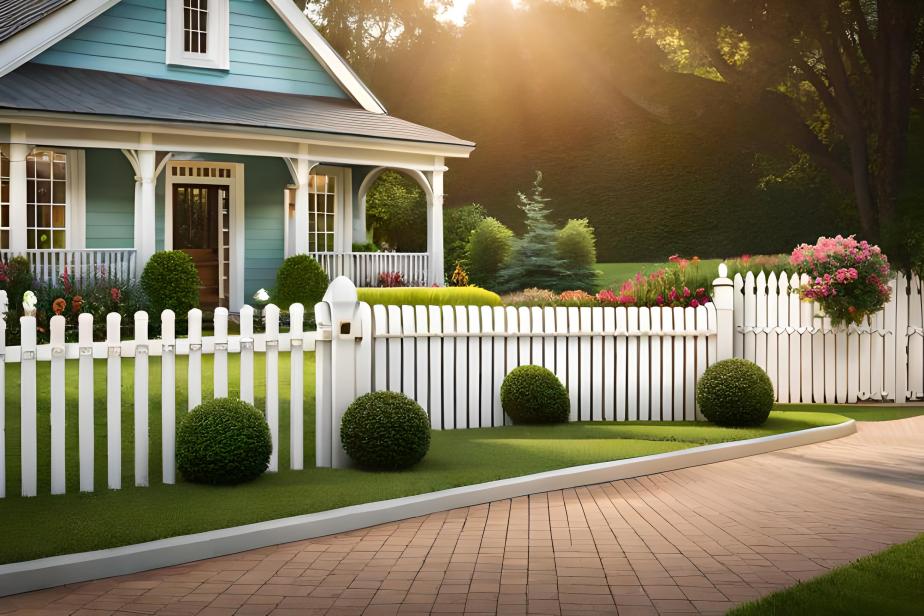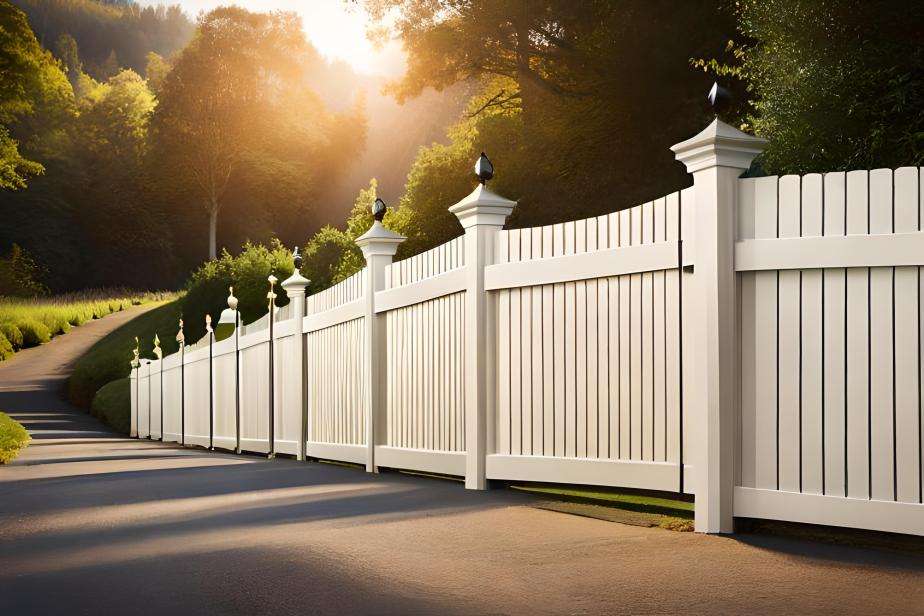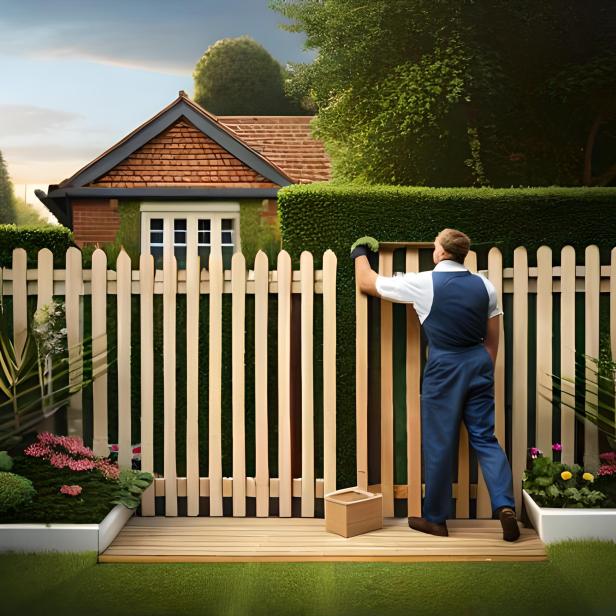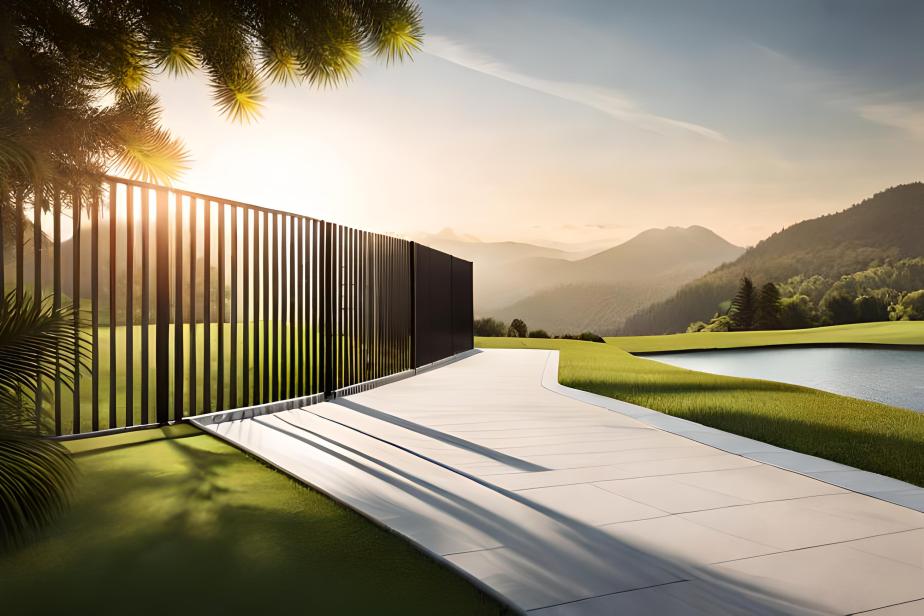I. Introduction
A well-selected and correctly installed front garden fence does much more than mark your property line. It boosts your home’s curb appeal, enhances privacy, secures your property, and can even play a role in maintaining local wildlife. This comprehensive guide delves into the world of front garden fences, bringing you many ideas, discussing various types, guiding you on choosing the right wall, examining cost factors, and even providing insight into the installation process. We aim to provide a broad yet detailed perspective to help you decide about your front garden fence.
II. The Role of Front Garden Fences
Front garden fences serve multiple purposes that are often overlooked. A fence demarcates your property at the most basic level, clearly setting boundaries. It’s an essential aspect of maintaining privacy, preventing any unwelcome intrusion. In terms of security, fences act as a deterrent to trespassers, be they human or animal. Last but not least, a well-chosen and designed fence can significantly enhance the aesthetic appeal of your front yard, contributing positively to your home’s overall look and feel.

III. Front Garden Fence Ideas
Traditional Wooden Fence
- Wooden fences are a classic choice for front gardens, and they can be painted or stained to match your home’s color palette. They are also relatively easy to maintain and can last many years with proper care.
- Some popular types of wooden fences include picket fences, split rail fences, and stockade fences.
- When choosing a wooden fence, it is important to consider the size of your front garden, the style of your home, and your budget.
Modern Metal Fencing
- Metal fences are a more contemporary option for front gardens, and they offer a sleek and modern look. They are also very durable and can withstand harsh weather conditions.
- Some popular types of metal fences include chain link fences, wrought iron fences, and aluminum fences.
- When choosing a metal fence, it is important to consider the level of security you need, the style of your home, and your budget.
Natural Greenery Fence (Hedges)
- A greenery fence is a living fence that can add a touch of nature to your front garden. It is also a great way to block out noise and provide privacy.
- Some popular greenery fences include evergreen, deciduous, and mixed hedges.
- When choosing a greenery fence, it is important to consider the amount of sunlight your front garden receives, the size of your front garden, and the type of privacy you need.
Ornamental Iron Fence
- Ornamental iron fences are a beautiful and elegant option for front gardens. They offer high security and can be customized to match your home’s style.
- Some popular types of ornamental iron fences include scrollwork fences, wrought iron fences, and wrought iron gates.
- When choosing an ornamental iron fence, it is important to consider the style of your home, your budget, and the level of security you need.
Picket Fence
- Picket fences are a classic American dream fence. They are stylish and versatile, and their timeless appeal is perfect for cottages and traditional homes.
- Picket fences are typically made of wood but can also be made of metal or vinyl.
- When choosing a picket fence, it is important to consider the size of your front garden, the style of your home, and your budget.
Bamboo Fencing
- Bamboo fences are a sustainable and eco-friendly option. They are strong, durable, and have a unique aesthetic that can give your garden a tropical or Zen ambiance.
- Bamboo fences are typically made of woven bamboo slats. They can be either natural or stained.
- When choosing a bamboo fence, it is important to consider the size of your front garden, the style of your home, and your budget.
Vinyl Fencing
- Vinyl fences resist rot and insects, require minimal maintenance, and are available in various styles and colors. They are a good option for busy homeowners who want a low-maintenance fence.
- Vinyl fences are typically made of PVC (polyvinyl chloride). They can be either solid or slatted.
- When choosing a vinyl fence, it is important to consider the size of your front garden, the style of your home, and your budget.
A Mix of Materials
- No rule says you must stick to just one material for your front garden fence. Mix and match different materials to create a unique fence design that meets your requirements and reflects your style.
- For example, you could combine a wooden fence with a wrought iron gate or a bamboo fence with a vinyl picket fence. The possibilities are endless!

IV. Types of Front Garden Fences
When choosing a fence, it’s crucial to understand the different materials available and their respective features and benefits. Here are some of the most common types:
Wood Fences
Wood fences are a popular choice for front gardens because they are relatively inexpensive, easy to install, and can be customized to match the style of your home. Wood fences are also a good option if you want an attractive and durable fence.
However, wood fences require regular maintenance to prevent rot, insects, and weather damage. Staining or painting your wood fence every few years would be best to protect it from the elements. You should also inspect your wood fence regularly for signs of damage and make repairs as needed.
Metal Fences
Metal fences are a more durable option than wood fences, and they require less maintenance. Metal fences are also more resistant to rot, insects, and weather damage. However, metal fences can be more expensive than wood fences and may not be as attractive to some homeowners.
Many different types of metal fences are available, including wrought iron, aluminum, and steel. Wrought iron fences are the most decorative type of metal fence but can also be the most expensive. Aluminum fences are a more affordable option, and they are also relatively lightweight and easy to install. Steel fences are the most durable type of metal fence but can also be the most expensive.
Vinyl Fences
Vinyl fences are a low-maintenance option that is resistant to weathering and rotting. Vinyl fences are also available in various styles and colors, so you can find one that matches your home’s décor. However, vinyl fences can be more expensive than other fences and may not be as durable as metal fences.
Composite Fences
Composite fences are made from a blend of wood and plastic, so they have the appearance of wood but require less maintenance and are resistant to rot and insects. Composite fences are also a good option if you want an attractive and durable fence. However, composite fences can be more expensive than other types of fences.
Natural Fences
Natural fences, such as hedges or shrub fences, can be a beautiful, eco-friendly option. They require regular maintenance and can take time to grow, but they offer habitat to beneficial insects and birds. Natural fences are also a good way to add privacy to your front garden.
V. How to Choose a Front Garden Fence
Choosing the right fence for your front garden depends on various factors. Here are some tips to guide your decision-making process:
Assess Your Needs
The first step in choosing a front garden fence is to assess your needs. What are you hoping to achieve with the wall? Do you need privacy? Security? A combination of both? Once you know what you need, you can narrow your options.
Local Regulations and Considerations
Before making any decisions, you must check local ordinances and homeowners’ association rules. Some areas have restrictions on fence heights, styles, or materials. It’s always best to check with local authorities to ensure your fence complies with all applicable regulations.
Climate and Weather Factors
The climate in your area will also play a role in your decision. If you live in a room with harsh winters, you must choose a material that can withstand the cold and snow. If you live in a room with hot summers, select a material that can withstand heat and sun.
Maintenance
How much maintenance are you willing to do? Some materials, such as wood, require regular staining or painting to prevent rot and decay. Other materials, such as vinyl, are low-maintenance and require little upkeep.
Neighbors
It’s also important to consider your neighbors when choosing a fence. You’ll want to select a design that complements the neighborhood’s overall aesthetic and doesn’t unnecessarily block your neighbors’ views.
VI. Cost of Front Garden Fences
The cost of your front garden fence will depend on the materials you choose, the size of your property, and whether you hire a professional or opt for a DIY installation. Here’s a breakdown of typical costs associated with each type of fence:
Material Costs
The cost of materials for a front garden fence will vary depending on the type of material you choose. Wood is usually the least expensive option, starting at around $10 per linear foot. Metal fences, such as wrought iron and aluminum, are more expensive, starting at about $20 per linear foot. Vinyl fences are also more costly than wood, starting at about $30 per linear foot.
Labor Costs
The cost of labor to install a front garden fence will also vary depending on the type of fence you choose and the size of your property. A DIYer can install a simple wooden wall for around $100 per linear foot. However, a more complex metal fence or vinyl fence may require professional installation, costing upwards of $200 per linear foot.
Maintenance Costs
The maintenance cost for a front garden fence will vary depending on the type of material you choose. Wood fences require regular staining or painting to prevent rot and decay. This can add $50-100 per year to the cost of ownership. Metal and vinyl fences are more low-maintenance but may still require occasional cleaning or repairs.
Total Cost
The total cost of a front garden fence will vary depending on the abovementioned factors. However, as a general rule of thumb, you can expect to pay between $100 and $500 per linear foot for a new fence. If you are on a tight budget, you may be able to find a used wall for a lower price.
You can get a more detailed breakdown of fencing costs here.

VII. Installing a Front Garden Fence
Once you’ve chosen the right fence for your needs and budget, it’s time to install it. Here are some steps to guide you:
Pre-installation
Before you start installing your fence, it’s important to do some preliminary work. This includes:
- Checking for utility lines. You don’t want to accidentally hit a buried utility line while digging holes for your fence posts. You can contact your local utility company to find out where the lines are located.
- Confirming your property lines. It’s important to ensure you’re installing the fence on your property, not your neighbor’s. You can use a surveyor’s map or a GPS device to confirm your property lines.
- Obtaining any necessary permissions or permits. Some municipalities require permits for fence installation. You can check with your local government to determine if you need access.
DIY Installation
If you’re handy and have the time, installing the fence yourself could save on labor costs. However, it’s important to be prepared before you start. Here are some tips for DIY fence installation:
- Plan your fence layout. Before you start digging holes, it’s important to plan how you want your fence to look. You’ll need to decide on the length and height of your wall and the spacing between the posts.
- Gather your materials. You’ll need to purchase the necessary materials for your fence, such as fence posts, panels, and fencing staples. You may also need tools like a post-hole digger, a level, and a hammer.
- Install the fence posts. This is the most important step in fence installation. The fence posts need to be concrete to be sturdy and not move.
- Attach the fence panels. You can attach the fence panels once the fence posts are in place. This is usually done by using fencing staples or screws.
- Finish the fence. Once the fence panels are attached, you may need to do some finishing work, such as staining or painting the wall.
Professional Installation
If you prefer to hire a professional, research to ensure you choose a reputable company. Ask for estimates from several companies and check reviews and references before deciding.
Here are some additional tips for hiring a professional fence installer:
-
- Get multiple estimates. This will help you compare prices and services.
- Check references. Ask the fence installer for references from previous customers.
- Make sure the installer is licensed and insured. This will protect you in case something goes wrong during the installation process.
VIII. Conclusion
Choosing the right front garden fence is a significant decision that requires careful thought and consideration. Whether you prioritize privacy, security, aesthetics, or a combination, there’s a fence out there that fits your needs. By understanding the different types of fences, their costs, and the installation process, you’ll be well-equipped to make an informed decision that adds value to your property.
IX. References and Additional Resources
- HomeAdvisor – Cost Guide
- DIY Network – How to Install a Fence
- This Old House – All About Wood Fences
- Pinterest – Wooden Fence Ideas
Whether you’re starting from scratch or replacing an existing fence, we hope this guide provides the comprehensive information you need to get started on your fencing project. Happy fencing!
X. Frequently Asked Questions (FAQs)
1. What is the most durable material for a front garden fence?
Metal fences, specifically steel or aluminum, are generally considered the most durable. They resist weather damage and typically require less maintenance than wooden fences.
2. Can I install a front garden fence by myself?
If you have the right tools and some basic DIY skills, installing a front garden fence yourself is possible. However, hiring professionals for more complex designs or materials is best if you are uncomfortable with the task.
3. How often will I need to maintain my wooden fence?
This depends on your local climate and the specific type of wood used. However, as a general rule, wooden fences should be checked annually for signs of damage and may need to be repainted or re-stained every 2-3 years.
4. Are there any legal restrictions on installing a front garden fence?
Local regulations vary, so you must check with your local council or homeowners’ association for any specific fence height, style, or materials rules.
5. How much does a front garden fence cost?
The cost of a front garden fence can vary significantly based on the type of fence, the material used, the size of your property, and whether you install it yourself or hire a professional. It’s best to obtain several quotes and consider all factors before deciding.
IX. Discover More on UltimateDesignDecor.com
This guide to front garden fences has only just scratched the surface of the incredible possibilities. If your imagination has been sparked and you’re eager to delve even deeper into fencing and outdoor design, we invite you to explore further on our site, UltimateDesignDecor.com. We have an exciting collection of articles on “Fence Design Ideas” that will surely inspire and guide you in your quest to create a beautiful and functional outdoor space. From the most avant-garde concepts to timeless classics, let’s continue this journey of transforming your front garden into an accurate statement of your style. Dive in and discover more today!

